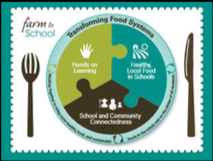A Q&A Lesson in Local Food Literacy: How can my school get started on shifting its whole school food culture?
Posted: February 22, 2018
Categories: Edible Education Network / GoodFoodBites / News from Sustain Ontario / Schools
 First we looked at getting students engaged, then we highlighted resources and ideas for school gardens — now, for the third blog post in our 10-post series on bringing Local Food Literacy into Ontario schools, we will explore shifting the culture around food in schools…
First we looked at getting students engaged, then we highlighted resources and ideas for school gardens — now, for the third blog post in our 10-post series on bringing Local Food Literacy into Ontario schools, we will explore shifting the culture around food in schools…
How can my school get started on shifting its whole school food culture?
Q: If we’re going to help our students adopt a love of good healthy food, we need a whole school food culture shift. This means getting good food in the cafeteria to connect students to their local farmers, weaving food literacy – such as how to have fun in the kitchen and how to eat well on a budget – into a range of school subjects, and changing our school fundraising model. It also involves getting other staff members, including our principal, to “buy in” and to value local food literacy. How can we get started on this?
While it can be tempting to want to overhaul your whole system right away, it’s important to know that great programs take time to build. If you want to get started keep these tips in mind:
Start small, do it well, and market the idea:

- Your small success story can create buy-in, encourage others to model the idea, and attract funding to scale up. E.g. start a worm bin, mushroom log, or seedlings in a classroom; or move from a successful window box to a raised outdoor garden.
- Calling it a “pilot” can be powerful: it’s a low-risk way to try something, see what happens, and learn for the next time.
Find & Engage Multiple Champions:
- School Champions. It takes many people to change a school’s food culture. You want champions from across the school: teachers from many subject areas, custodians, administrators, parents, clubs, etc. Ideally the whole school will be involved. Odds are there is at least 1 other teacher, 1 support staff, 1 parent who supports your idea. Start building a team of interested and excited folks who can help others see the work’s value.
- Community partners. Many people want to support schools including dietitians, nutritionists, child & youth workers, carpenters, agronomists, structural engineers, master gardeners, caterers, fundraisers… These partners can fundraise, provide expertise, host workshops and field trips, do advocacy, provide Professional Development, and be caring adults in the school for students.
There are plenty of exciting ways to engage and empower students, while involving others from the community, like parents. A primary public school teacher from Toronto shared with us one of their ideas: “Students hosted a fundraiser event where parents bought produce that the kids had harvested and packaged themselves from the tower, and all parties were thrilled with the experience. The students felt empowered that they could make money off of their efforts of taking care of the tower, and the parents got to be directly involved with and supportive of the towers.”
Ask: “How do we solve problems without creating new work?” This involves working with (not against) what’s being served in the cafeteria or what’s being taught in the school. A school food champion can then start to introduce ideas that excite them.

Find inspiration from other schools like Kingsville Public School, where students are learning about cooking, growing and buying locally
For some School Food Champ inspiration, check out this past blog post where we highlighted some fabulous individuals who were nominated and celebrated for their efforts in championing good food in Ontario schools!
Get to understand your staff members’ focus and connect it to the garden. Is your Administrator focused on increasing attendance? Many studies show that attendance rates increase when students participate in food programs.
Find other schools that are doing what you want to do. Invite teachers and principals from neighbouring schools to visit your gardens and ask if you can visit other schools. After seeing a space in person people often feel more confident about having something in their own school space.
Show them the data. There is a wealth of literature about the positive effects of food programs at school. We’ve compiled some on our Impacts of Good Food Education page.
Track your progress. It’s important to develop an evaluation plan at the start of a project.
- Ask what success will look like and develop a set of measurable indicators to track your progress.
- Develop a plan to record hard data, such as the pounds of food you’ve grown or number of meals you’ve made with local ingredients.
- Ask questions about the impact of your work.
Combining data with stories about the project’s impact can help you communicate project successes to key stakeholders and funders.
Check out the Farm to School model:
Farm to Cafeteria Canada
http://www.farmtocafeteriacanada.ca/
The Farm to School (F2S) movement supports a broad school food culture. This website provides F2S resources including Fact Sheets, Stories from the Field, Videos, and Toolkits.
For more ideas, watch our webinar recording, Embracing Local Food Literacy in Ontario Schools: Shifting your School Food Culture.
As always, if you have any other ideas or resources to share on the topic, please join the #LocalFoodLiteracy discussion on Twitter!
Content from this blog post series comes from the Local Food Literacy in Schools FAQ Guide, developed by Sustain Ontario, Ecosource, FoodShare and Roots to Harvest.

